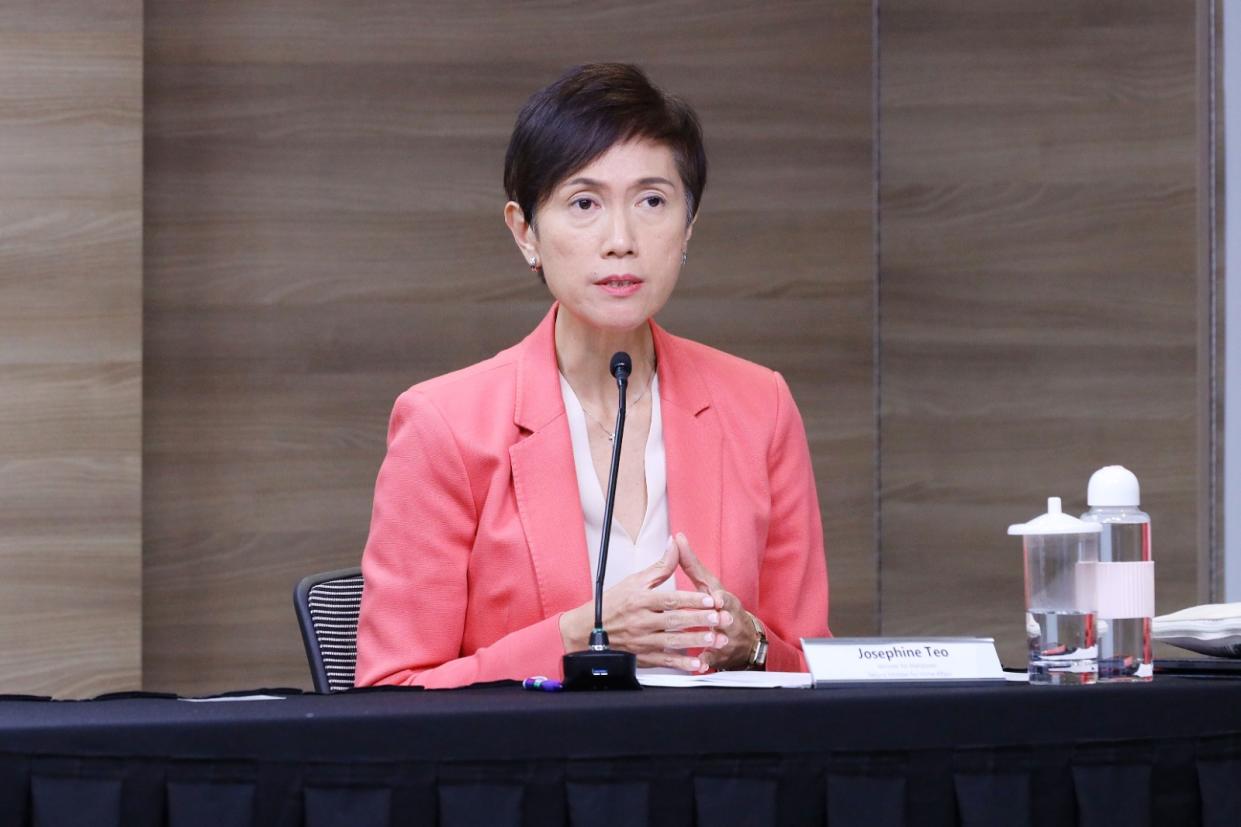COVID-19: Migrant workers were on MOM's radar since January – Josephine Teo

SINGAPORE — Foreign workers have been in the authorities’ sight early on in the COVID-19 outbreak in Singapore at the start of the year, said Manpower Minister Josephine Teo on Monday (4 May).
Delivering a ministerial statement in Parliament, she explained how the Ministry of Manpower (MOM) helped to prevent imported cases by limiting the return of work pass holders and monitoring returnees’ compliance with Leaves of Absence and Stay-Home Notices, among other things.
“Throughout this period, migrant workers were also on our radar,” said Teo.
“The day after the first confirmed case in Singapore (in January), MOM reached out to dormitory operators to be more vigilant and to step up hygiene. In fact, one of the earliest media conferences that Minister Lawrence Wong and I held was at the Tuas View Dormitory, after we inspected their quarantine facilities (in early February),” she said.
Wong helms the National Development Ministry and co-chairs the Multi-Ministry Taskforce tackling the spread of the virus.
Teo added, “We produced materials in the workers’ native languages to encourage them to take steps to protect themselves. Subsequently, non-essential facilities in the dormitories like gyms and TV rooms were closed. Meal-times and recreational hours were staggered. Intermixing between blocks was stopped.
“MOM officers also fanned out on weekends, to advise migrant workers to observe safe distancing measures and disperse big groups that were gathering at popular hangouts.”
‘Focus on rooming arrangements on their own may not prevent recurrence’
In February, the authorities detected the first COVID-19 cluster involving migrant workers at a construction site at Seletar Aerospace Heights. The five workers stayed at five different locations, only two of which were dormitories, Teo noted.
“Thereafter, there was no indication of higher prevalence of COVID-19 among migrant workers, compared to the general community,” she said.
Several MPs had raised queries on the outbreak of COVID-19 in dormitories. Jurong GRC MP Ang Wei Neng asked, among other things, about the lessons to be drawn from the management of dormitories and if safe distancing can be “practically practised” in the existing purpose-built dormitories.
Meanwhile, Nee Soon GRC MP Louis Ng asked if MOM would consider raising the minimum gross floor area of 4.5 square metres for each resident in a foreign workers' dormitory; and not including the basic living facilities - such as living quarters, kitchen, dining, and toilet areas - in the computation for the minimum gross floor area.
Nominated MPs Walter Theseira and Anthea Ong also asked if a Committee of Inquiry would be appointed to probe the COVID-19 outbreak in the dormitories.
Responding, Teo said epidemiological findings show that within the dormitories which have clusters, not all blocks or rooms are equally affected. And across the different dormitories, infected workers were linked via common work sites.
“At the work sites, it was not uncommon for the infected workers to take breaks together, share food and utensils. Likewise, infected workers from different dormitories had gathered during their rest days to socialise and shop, for example at Mustafa Centre. Back in the dormitories, workers spent time with their friends, cooking, eating and relaxing together,” said Teo.
“The virus may have spread through all of these activities, much like how it spread among family members, religious groups and even colleagues,” she added.
Teo also noted that most infected workers showed mild symptoms of the virus and that many cases were uncovered only due to active case-finding or swab-taking.
“This may explain why up to the middle of March, the cases of workers at the dormitories testing positive were few and far between. Once evidence emerged that the virus had spread in the dormitories, we decided to deal with it squarely and quickly, and mobilise whole-of-government resources,” the minister said.
She added, “Multiple channels of transmission among migrant workers, as appear to be the case, also means that we have to employ a multi-faceted approach to dealing with the outbreak. A focus on rooming arrangements on their own may not prevent a recurrence. This consideration underpins the comprehensive approach of the Taskforce.”
NMP Anthea Ong on apology
The Ministry of Health reported a preliminary 573 new COVID-19 cases in Singapore as of Monday noon, bringing the total to 18,778. As of Sunday, more than 15,800 workers living in dormitories have come down with the virus.
Ong also asked whether the authorities would apologise for the large number of COVID-19 cases in the dormitories.
In response, Teo said her ministry interacted very closely with the workers on a very regular basis at and outside the dormitories. The workers wanted to know how the authorities can help in the current situation, such as taking care of them if they were to fall sick, and ensuring that they can get their wages and send the money back home.
“These are the things that they have asked of us. I have not come across one single migrant worker himself that has demanded an apology,” Teo said.
Stay in the know on-the-go: Join Yahoo Singapore's Telegram channel at http://t.me/YahooSingapore
Other Singapore stories:
About 40 instances of COVID-19 'fake news' debunked since January: S Iswaran
COVID-19: Singapore to expand testing capacity, 'strategically' deploy resources
COVID-19: Gan Kim Yong outlines 3 indicators for easing circuit breaker measures
COVID-19: Singapore confirms 573 more cases, total at 18,778



